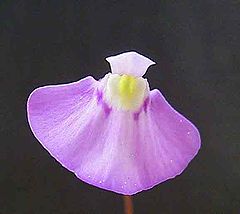Utricularia uniflora: Difference between revisions
Created page with '{{SPlantbox |familia=Lentibulariaceae |genus=Utricularia |species=uniflora |habit=herbaceous |habit_ref=Flora - A Gardener's Encyclopedia |Max ht box=8 |Max ht metric=in |height…' |
No edit summary |
||
| Line 1: | Line 1: | ||
{{SPlantbox | {{SPlantbox | ||
|familia=Lentibulariaceae | |familia=Lentibulariaceae | ||
|genus=Utricularia | |genus=Utricularia | ||
|species=uniflora | |species=uniflora | ||
|habit=herbaceous | |habit=herbaceous | ||
| Line 19: | Line 19: | ||
|usda_ref=Flora - A Gardener's Encyclopedia | |usda_ref=Flora - A Gardener's Encyclopedia | ||
|max_zone=11 | |max_zone=11 | ||
|image= | |image=Utriculariauniflora1web.jpg | ||
|image_width=240 | |image_width=240 | ||
}} | }} | ||
'''''Utricularia unifolia''''' is a medium-sized [[perennial plant|perennial]] [[carnivorous plant]] that belongs to the [[genus]] ''[[Utricularia]]''. ''U. unifolia'' is native to [[Central America]] ([[Costa Rica]], [[Nicaragua]], and [[Panama]]) and western [[South America]] ([[Bolivia]], [[Colombia]], [[Ecuador]], [[Peru]], and [[Venezuela]]). It was originally published and described by [[Hipólito Ruiz López]] and [[José Antonio Pavón Jiménez]] in 1797 and later considered a synonym of ''[[Utricularia alpina]]'' until [[Peter Taylor (botanist)|Peter Taylor]]'s 1989 [[monograph]] on the genus where he restored the species as distinct from ''U. alpina''. It grows as a terrestrial or [[epiphyte|epiphytic]] plant on moss-covered trees, rocks, or banks in [[cloud forest]]s at altitudes between {{convert|2000|m|ft|0|abbr=on}} and {{convert|3000|m|ft|0|abbr=on}}. ''U. unifolia'' usually produces only one leaf (rarely two or three), which is where the species [[epithet]] "unifolia" is derived from.<ref name="Taylor 1989">Taylor, Peter. (1989). ''The genus ''Utricularia'': A taxonomic monograph.'' Kew Bulletin Additional Series XIV: London.</ref> | |||
==Cultivation== | ==Cultivation== | ||
Latest revision as of 20:59, 5 May 2010
| Utricularia uniflora subsp. var. | ||||||||||||||||||||||||||||||||||||||||||||||||||||||||
|---|---|---|---|---|---|---|---|---|---|---|---|---|---|---|---|---|---|---|---|---|---|---|---|---|---|---|---|---|---|---|---|---|---|---|---|---|---|---|---|---|---|---|---|---|---|---|---|---|---|---|---|---|---|---|---|---|

|
|
| ||||||||||||||||||||||||||||||||||||||||||||||||||||||
| ||||||||||||||||||||||||||||||||||||||||||||||||||||||||
Utricularia unifolia is a medium-sized perennial carnivorous plant that belongs to the genus Utricularia. U. unifolia is native to Central America (Costa Rica, Nicaragua, and Panama) and western South America (Bolivia, Colombia, Ecuador, Peru, and Venezuela). It was originally published and described by Hipólito Ruiz López and José Antonio Pavón Jiménez in 1797 and later considered a synonym of Utricularia alpina until Peter Taylor's 1989 monograph on the genus where he restored the species as distinct from U. alpina. It grows as a terrestrial or epiphytic plant on moss-covered trees, rocks, or banks in cloud forests at altitudes between 2000 m ft 0 and 3000 m ft 0. U. unifolia usually produces only one leaf (rarely two or three), which is where the species epithet "unifolia" is derived from.[1]
Cultivation
Propagation
Pests and diseases
Varieties
Gallery
-
photo 1
-
photo 2
-
photo 3
References
- ↑ Taylor, Peter. (1989). The genus Utricularia: A taxonomic monograph. Kew Bulletin Additional Series XIV: London.
External links
- w:Utricularia uniflora. Some of the material on this page may be from Wikipedia, under the Creative Commons license.
- Utricularia uniflora QR Code (Size 50, 100, 200, 500)
